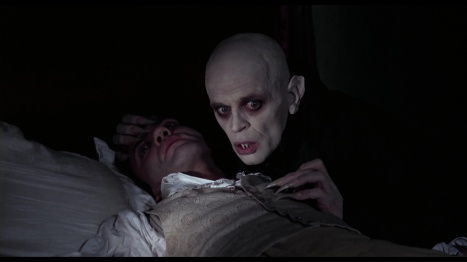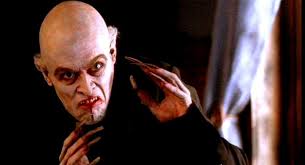Even today, people still wonder if it was all an act.
Nearly a century later, we can’t all agree if Max Schreck was “simply” a fine actor who put everything together at just the right time, or if he might have been… something else. Something that made his title character work in Nosferatu much easier than a performing job. Something that might have transformed a later version of the storyline from horrific to realistic.
Of course, of course, as is almost always the case, the reality is a bit less juicy, feel free not to pardon the pun. But let’s learn about the man whose work set the tone for a story by a man named Stoker.
Or what little there is. Schreck was born in Berlin in 1879 and got rolling in the theater industry before churning out over thirty films in the 1920s and 30s. However, like Lugosi after him, Schreck would be forever indistinguishable from the fanged one.
Perhaps a big reason why such a mystique was created about Schreck is that so little is known of him as a man, and that’s just the way the intensely private person wanted. A husband but never a father, he passed away in 1936, long before the mystique of Count Orlok reached its legendary status.
With little reality at all to work with and certainly no dirty little secrets or scandalous publicity, sometimes some of us decide to make something for ourselves. Take the fact that the actor’s surname is German for “fear.” Add the constant jokes about tracing the roots of his family tree back to Stoker’s original inspiration. If a fable gets told enough times to the right people, particularly those who enjoy stomping on the line between fantasy and reality, and someone will run too far with it – and Hollywood is just the sort of place to encourage that sort of thing, as a tale we’ll tell about in a few moments will reveal.
In 1838 Transylvania, young real estate agent Hutter (Gutav von Wangeheim, a name that sounds just like a comedic Hollywood character) finds his ticket to financial fame in a chance to sell the castle of the ominous and somehow filthy rich Orlok.
As is the case with many horror villains (Hannibal Lecter is a great example) Orlok is discussed in all kinds of detail before we actually get our eyes on him – he gets less than ten minutes of screen time for the full flick – and yet his dark aura hangs over things like a stormcloud from credits to credits (the film was dark enough that Swedish theaters couldn’t show it until the 1970s).
With Hutter now his prisoner, Orlok feels the mental connection between Hutter and his wife Ellen (Greta Schroder), herself still in Germany. Still brooding over a love he once lost, Orlok leaves his home to find her, with Hutter in pursuit. Believing that it’s the only way to purge the world of Orlok’s evil, Ellen allows him to feast upon her, holding him as her own mental captive until he doesn’t notice the sunrise that will end his life. Tragically, the deed takes hers as well, as she dies in Hutter’s arms.
Deemed, perhaps unfairly so, as “strikingly ugly,” by director F.W. Murnau, Shreck was adorned with fangs and oversized ears to step into Orlok’s life. Schreck was considered a natural introvert, living in his own “remote and strange world… (spending) hours walking through dense, dark forests,” so he probably got some preparation from his personality. As Lecter and so many other bad guys would imitate, he also blinked as little as possible, taking on the hypnotic edge that vampires so often exude.
Aside from that, though, there’s little commonality between Orlok and later Draculas. Bela Lugosi, Christopher Lee, Gary Oldman, and others typically made their men charismatic, even seductive, Schreck’s Orlok is more standoffish, less confident (to be fair, he had to work without speech, which all else could utilize), though the scene where he licks blood off Hutter’s hand clearly has a homoerotic air to it. It’s rumored that Boris Karloff used Schreck’s work to get ready to become Frankenstein’s monster.
Though Nosferatu wasn’t the first time that Bram Stoker’s novel switched from page to screen (the long-lost Hungarian production Drakula of 1921 appears to have that honor), it certainly pissed the hell out of Stoker’s estate; his widow Florence sued the crew for changing the story – rumors are that they’d attempted to do a straightforward telling of Dracula, but that the estate had wanted too much green. Nearly every print of the film was destroyed or mutilated in editing, making it all but impossible to get the full tale today (I managed to find it on Netflix).
That’s about all there is to tell about Schreck’s past – but his present (our present) and future are still going strong. Even those who haven’t seen Nosferatu might be wondering where they heard his moniker before; it was that of Christopher Walken’s evil businessman in Batman Returns. Back in 1979, Werner Herzog put together Nosferatu: Phantom der Nacht, with his longtime collaborator Klaus Kinski in Schreck’s place.
“If you are something, you automatically believe in it,” said Kinski, before the camera five times for Herzog. “You point it out so much that you accept it. It wouldn’t be in me, if I couldn’t feel the metamorphosis. I look as I have to look, or I wouldn’t accept (the role). You don’t think about it being nice; it’s how it has to be.” With four hours a day in the makeup chair and atop lifts to add three inches to his height, Kinski was trained on utilizing Orlok’s nails.
“I shaved my head for the first time,” he recalled. “I feel exposed, deserted, defenseless, not only physically – my head is as sensitive as an open wound – but essentially spiritually. It’s as if my soul had been exposed to the sun’s piercing light.” Perhaps he was feeling Orlok’s terror at the vampire’s climactic passing near the end.
“When I play a character, even if he’s the most despicable person in the world, I become him for the duration of the production,” Kinski says. “This vampire is someone millions can identify with. He personifies the mingled sadness and desire of people who want to kill themselves because they can’t live without physical and spiritual love.” Kinski, who turned down a chance to work with Steven Spielberg in Raiders of the Lost Ark, passed away around Thanksgiving 1991.
“From Kinski’s vampire, you get real existential anguish,” Herzog says. “I tried to humanize him. I wanted to endow him with human suffering and solitude, with a true longing for love and, importantly, the one essential capacity of human beings: mortality.”
Decades later, Nosferatu was remade again – and this time, things went much farther in a new direction. As terrifying as the first versions of Nosferatu had been, E. Elias Merhige put together a new way to use it to scare, a subdivision of the horror genre.
The tale of 2000’s Shadow of the Vampire came from the audience looking from the outside in, at those even farther on the inside. As John Malkovich’s Murnau leads his crew to the former Czechoslovakia to shoot Nosferatu, whispers roll amongst the crew of the fellow playing the Count himself.
They know his name – and forever, that’s all. The Max Shreck they know will only appear in character. As things get rolling, strange stuff occurs. Blood is found in the catering. Cast members start to look sluggish. The scene where von Wangeheim’s Hutter (played by Eddie Izzard) cuts his hand becomes accidental, as does Orlok’s interest in his plasma.
Eventually, the sad and scary truth comes out; Murnau and Orlok are working together. Desperate for credibility, the director hired a real vampire for the role, promising him the fake Mina (Catherine McCormack) as a paycheck.
Getting ready to be the count, Willem Dafoe went back to Shreck’s work.
“That gave me some idea of the physicality and the way of being,” he says of the original. “They designed the makeup that was quite extreme, and served as a mask, a disguise that would take myself away from myself and put me someplace else. When you don’t quite feel like yourself and look like yourself, that’s always a fertile place for pretending.”
For over three hours a day, he sat in a makeup chair as the crew did work that would eventually garner an Oscar nomination (the brief moment of comedy when Murnau denies Shreck makeup was an inside joke to this). Dafoe’s acting would be nominated as well, rare for a horror film.
“To believe this film is not fiction, you have to believe in vampires,” he says. “If you do believe in vampires, I can’t help you… I started from a place of imitation, and then dealing with all these external things to help me find a way of moving and a way of being.”
References
Nosferatu DVD
Nosferatu: Phantom Der Nacht DVD
Shadow of the Vampire DVD
Wagner, Laura. (2010, Fall). Shadow of a Vampire. Films of the Golden Age, 62. 68-73.
